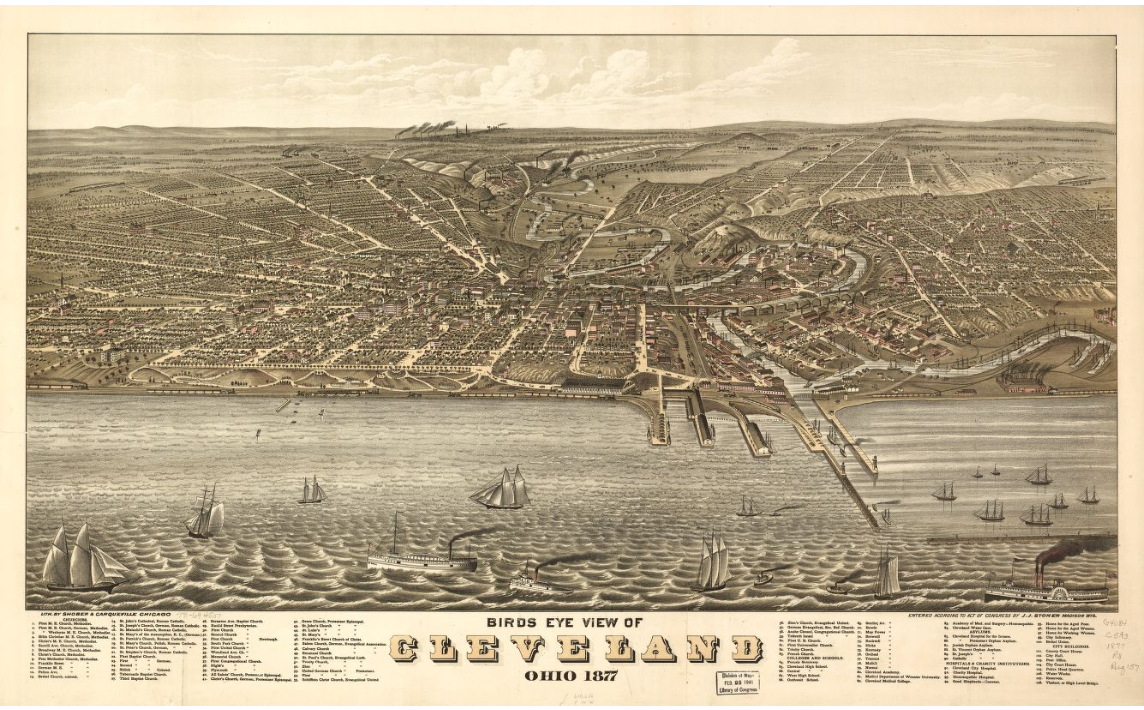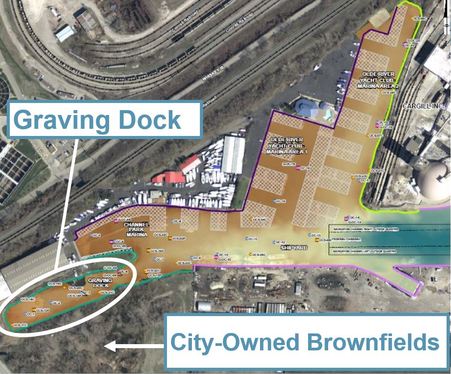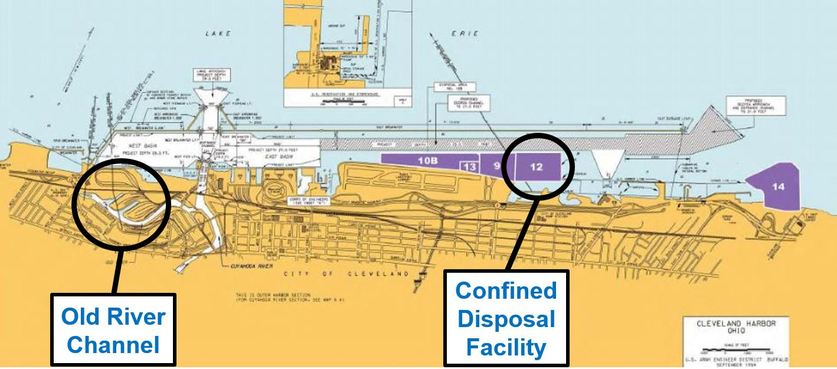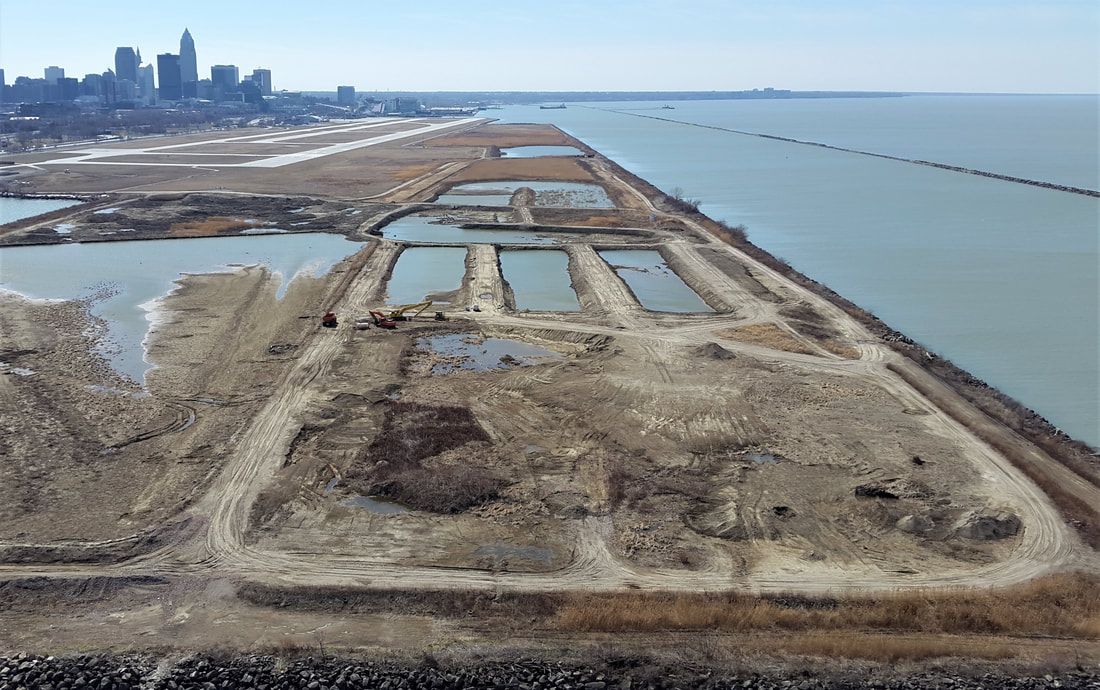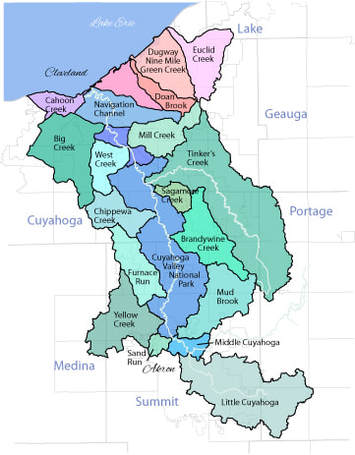Site History
|
The lower Cuyahoga River has been modified several times over the last 200 years. Today, it empties into Lake Erie through the navigation channel west of Downtown Cleveland. A mile-long extension, called the Old River Channel, was built in 1827 and branches off the main channel before it reaches the lake. By the 1900s, the Cuyahoga River became known as one of the most polluted rivers in the country. Oil slicks on the river caught fire several times, the first occurring in 1868. The infamous 1969 fire caught the attention of Time magazine, resulting in a scathing piece on the state of river. The article incited a national movement to address water pollution, giving rise to the Clean Water Act and the Great Lakes Water Quality Agreement.
Despite progress, contaminants persist in the sediment of the Old River Channel. Through its history, part of the channel was used for industrial waste disposal by a printing plant and a battery factory. In concert with ongoing restoration efforts throughout the Cuyahoga River Area of Concern, remediation could restore beneficial use of the site for the communities of Northeast Ohio. |
Location
The former graving dock at the westernmost end of the Cuyahoga River Old Channel (CROC) has the highest concentrations of contaminants. To the north and the east lie the Olde River Yacht Club and the Channel Park Marina. Along the southern banks of the Old Channel, there is a privately-owned shipyard and a number of city-owned brownfields. An investigation through Ohio EPA’s Voluntary Action Program found that the sources of pollution in these brownfields are controlled and recontamination is not a concern.
|
The Old River Channel branches off the main navigation channel and lies within the Cuyahoga River Area of Concern. The marker on this map shows the location of the graving dock site.
|
Schedule |
Cleanup Process |
|
The multi-phase dredging project is currently being designed.
|
Sediment to be remediated: ~100,000 cubic yards
Contaminants: PAHs, PCBs, metals, oil & grease Method: Dredging Partners: Northeast Ohio Regional Sewer District, Port of Cleveland Cost: $23.1 million (Phases 1 & 2) |
Short-term Disruptions
Sediment remediation is like a construction project on the water. It can involve large equipment, bright lights, and noise. Many projects even continue into the night and on weekends to speed up the process. Remediation can feel inconvenient, but a bit of patience results in a big payoff.
Public Impacts:
Public Impacts:
- Phase 1: Minimal impact. Construction activities will be at the CDF.
- Phase 2: Increased barge traffic in Federal Navigation Channel.
- Phase 3: Dredging will be conducted outside of boating season.
Long-term Benefits
|
Community Involvement
The Cuyahoga River Old Channel (CROC) may feel a bit tucked away from the everyday bustle of community life, but cleanup actions will have far-reaching impacts on the health of Lake Erie, as well as the local economy of Cleveland. Contact U.S. EPA project manager, Kali Denis to provide input on the project, ask questions, or to coordinate the project with community events on the river.
May 15, 2024 Cuyahoga River Old Channel Public Information Meeting
May 15, 2024 Cuyahoga River Old Channel Public Information Meeting
- U.S. EPA and project partners presented on the project cleanup design.
- Public Notice
More Information
Documents and Resources
CROC May 15 2024 Public Information Meeting Slides (PDF, 25p, 5.5MB) May 2024
CROC May 2024 Fact Sheet (PDF, 2p, 2.3MB) May 2024
CROC Remedial Footprint Poster (PDF, 1p, 2.1MB) May 2024
CROC Confined Disposal Facility Poster (PDF, 1p, 3.3MB) May 2024
Stakeholders
City of Cleveland
Ohio Lake Erie Commission
Great Lakes Towing
Cuyahoga River Restoration
Friends of the Crooked River
Cuyahoga Valley National Park
Ohio Environmental Protection Agency
Ohio Sea Grant
U. S. Environmental Protection Agency
U.S. Army Corp of Engineers
CROC May 15 2024 Public Information Meeting Slides (PDF, 25p, 5.5MB) May 2024
CROC May 2024 Fact Sheet (PDF, 2p, 2.3MB) May 2024
CROC Remedial Footprint Poster (PDF, 1p, 2.1MB) May 2024
CROC Confined Disposal Facility Poster (PDF, 1p, 3.3MB) May 2024
Stakeholders
City of Cleveland
Ohio Lake Erie Commission
Great Lakes Towing
Cuyahoga River Restoration
Friends of the Crooked River
Cuyahoga Valley National Park
Ohio Environmental Protection Agency
Ohio Sea Grant
U. S. Environmental Protection Agency
U.S. Army Corp of Engineers
